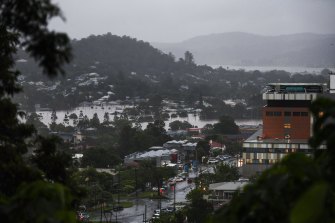Home » World News »
The facts we need to face if Australia’s coastal towns are to survive devastation
Here we go again. In northern NSW and south-east Queensland we are once more witnessing a high intensity rainfall and flood crisis. Lismore is suffering terrible flooding, the Clarence River is about to overflow its banks, and if the weather system moves south, Port Macquarie will get hit again, less than a year after the record-breaking floods in March 2021.
At times like this, we must respond with facts on what is driving such extreme weather. Since the north Queensland floods in 2019, there have been 137 disasters declared in 398 local government areas, covering close to 20 million Australians. This is an ongoing threat to our safety and security and local economies.
The town of Lismore has been inundated as heavy rainfall pushed the Wilson River over its banks.Credit:Elise Derwin
Humanity is interfering with natural Earth systems. As we burn fossil fuels and destroy forests, we are adding energy to the climate. For every degree of global warming, the atmosphere holds 7 per cent more water. Climate models show global warming increases the risk of intense rainfall by more than 20 per cent. Extreme rains and record floods have increased since 1950. Climate change doesn’t cause these events, but it makes them worse.
Living on or near the coast makes communities more vulnerable. Warmer oceans create more evaporation, leading to higher rainfall. A warmer atmosphere holds more water, means higher rainfall. High intensity rainfall and flooding are becoming worse and breaking records.
Today, in northern NSW and south-east Queensland, flood records are toppling. The SES says “we are talking record-breaking floods”. The future doesn’t look good for all locations that are prone to these events. The message is clear – we need to understand that climate change is real and governments need to act, pushed on by people power.
Federal Coalition government policies come nowhere near to tackling the problem here and now. In fact, they are making it worse by funding fossil fuel projects and approving land clearing. Nor is their funding for climate adaptation measures and disaster recovery anything like enough. State and
local governments also have an important role to play.
Every structure, be it a roadside gutter, a bridge, or an office block, is built to withstand a flood of a given size. But as rainfall changes, we need to re-design and build these structures to withstand more destructive floods. Business suffers too in multiple ways – just ask the shop owners in Gympie and Lismore right now.
It may feel uncomfortable, and many people may want to deny it, but we need to have a serious talk about climate change. We must do everything we can to help those affected, and we need to confront the elephant in the room – climate change is here, and it’s doing the damage and threatening our lives and the way of life we treasure as Australians.
It’s affecting all Australians and our Pacific and Asian neighbours. These are not easy conversations to have, but with each flood, bushfire, heatwave, drought and other natural disaster made worse by human-induced climate change, they are conversations we must get better at having.
Harry Creamer is a mid north coast climate campaigner, and member of Climate Change Hastings.
Most Viewed in National
Source: Read Full Article



